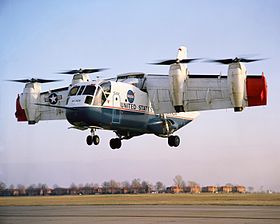The Ling-Temco-Vought XC-142A was a prototype V/STOL designed in a joint project of the Army, Navy, and Air Force.
 The first prototype made its first conventional flight on 29 September 1964, the first hover on 29 December 1964, and the first transition on 11 January 1965. The first XC-142A was delivered to the Air Force test team in July 1965. During the XC-142A program, a total of 420 hours were flown in 488 flights. The five XC-142As were flown by 39 different military and civilian pilots. Tests included carrier operations, simulated rescues, paratroop drops, and low-level cargo extraction.
The first prototype made its first conventional flight on 29 September 1964, the first hover on 29 December 1964, and the first transition on 11 January 1965. The first XC-142A was delivered to the Air Force test team in July 1965. During the XC-142A program, a total of 420 hours were flown in 488 flights. The five XC-142As were flown by 39 different military and civilian pilots. Tests included carrier operations, simulated rescues, paratroop drops, and low-level cargo extraction.
During testing, the aircraft’s cross-linked driveshaft proved to be its Achilles heel. The shaft resulted in excessive vibration and noise, resulting in a high pilot workload. Additionally, it proved susceptible to problems due to wing flexing. Shaft problems, along with operator errors, resulted in a number of hard landings causing damage. One crash occurred as a result of a failure of the driveshaft to the tail rotor, causing three fatalities. One of the limitations found in the aircraft was an instability between wing angles of 35 and 80 degrees, encountered at extremely low altitudes. There were also high side forces that resulted from yaw and weak propeller blade pitch angle controls. The new “2FF” propellers also proved to generate less thrust than predicted. (1)
On October 9, 1967, the second (of five) Ling-Temco-Vought XC-142As, 62-5922 suffered major landing gear and fuselage damage during STOL landing at Edwards AFB, California. This followed a 28-minute functional check flight after the incorporation of modified control system components. The crew was uninjured. This was the 488th test flight of the XC-142 program, and it turned out to be the last one before the program was canceled. The airframe was not repaired. (2)
Sources: Wikipedia and Wikipedia Portal Aviation
